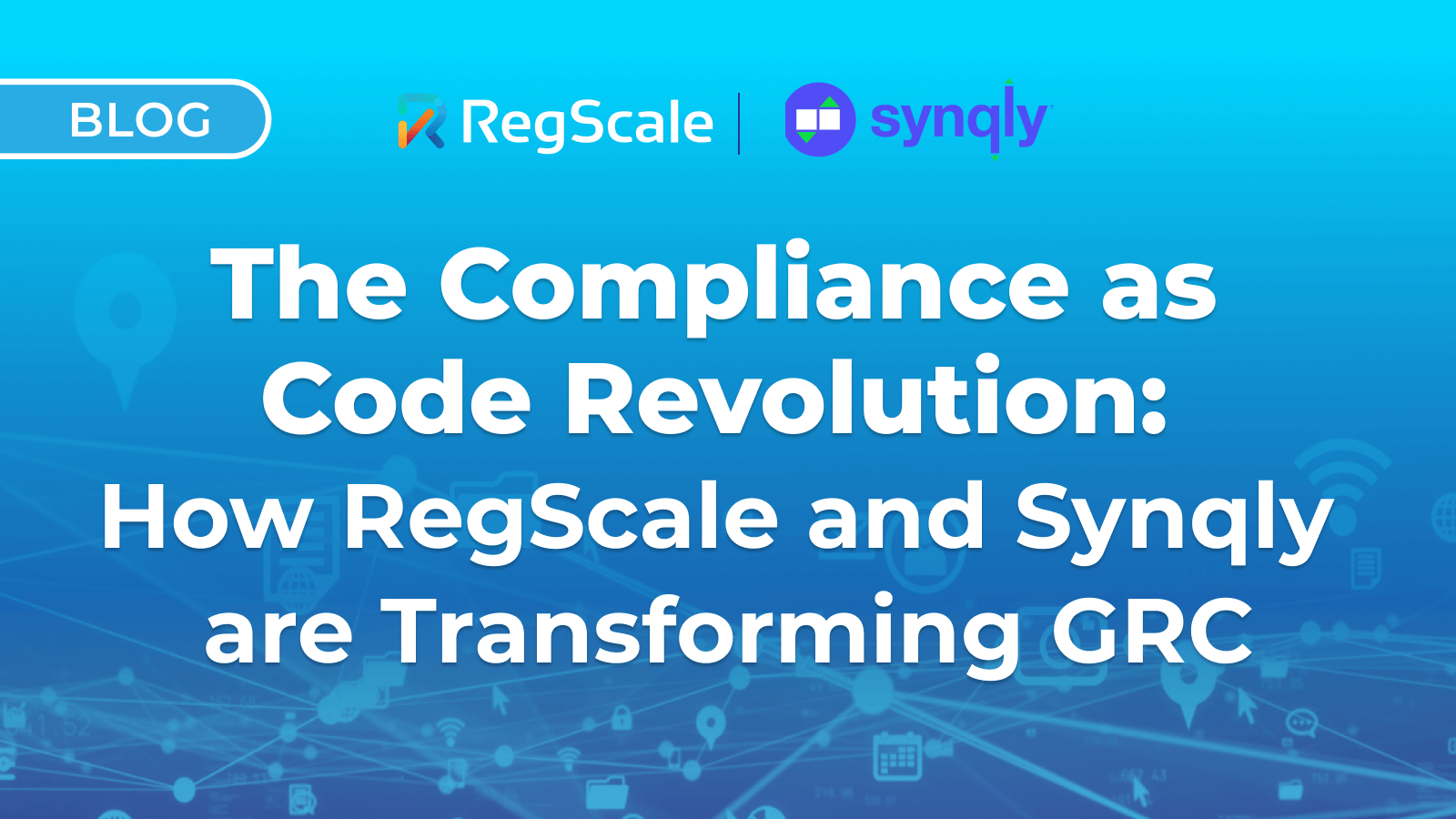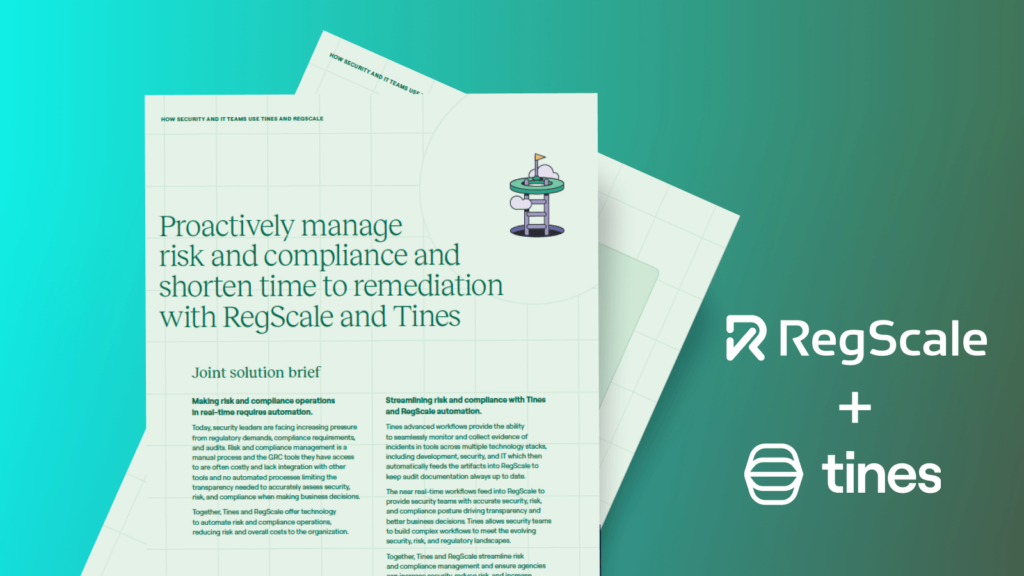The Compliance as Code Revolution: How RegScale and Synqly Are Transforming GRC with OSCAL and OCSF

If you’ve spent any time in the compliance trenches, you know the drill: the mad scramble before audits, the late nights documenting controls, and the constant friction between security requirements and development velocity. It’s an environment where compliance teams burn out while developers grow frustrated with roadblocks.
The truth is, we can’t keep throwing more people at compliance problems and expecting different results. The spreadsheets and manual evidence gathering simply don’t scale with modern development practices. What we need is for compliance to evolve from manual, point-in-time processes to proactive, automated solutions.
Compliance as code offers a solution. By embedding compliance checks directly into CI/CD pipelines and cloud hosting environments, organizations can achieve continuous audit readiness with minimal overhead and continuously demonstrate compliance across their development lifecycle.
The benefits are substantial: improved developer productivity, faster release velocity, real-time compliance verification, and elimination of tedious manual processes. By treating compliance as an engineering problem rather than a documentation exercise, businesses can finally break free from the manual burden of GRC — and we’ll show you how.
The power of open standards: OSCAL and OCSF
At the foundation of compliance as code and modern GRC automation are two critical open standards: the NIST Open Security Controls Assessment Language (OSCAL) and the Open Cybersecurity Schema Framework (OCSF).
OSCAL is a set of formats for representing control catalogs, control baselines (profiles), system security plans (SSPs), and assessment/issue data in a standardized way. OSCAL enables automation by turning human-created compliance documentation into structured, machine-readable data formats like JSON, XML, and YAML. It’s particularly critical for FedRAMP certification, and it’s poised for wider adoption across industries like financial services via the Cyber Risk Institute (CRI).
OCSF is a collaborative, open-source schema for standardizing raw telemetry from scanners, security information and event management solutions (SIEMs), endpoint detection & response tools (EDRs), configuration management databases (CMDBs), and more. Launched by a collective of cybersecurity leaders including AWS and IBM, OCSF is a Linux Foundation project designed to address the fact that every security tool speaks a slightly different language. It provides a vendor-agnostic way for a wide range of security tools to communicate security event data clearly with each other.
Both open standards are critical components of compliance automation, enabling automated controls monitoring, documentation generation, and continuous monitoring.
Compliance as code with RegScale and Synqly
RegScale’s Continuous Controls Monitoring (CCM) platform transforms how organizations approach compliance. With OSCAL-driven compliance as code, RegScale offers automated security and compliance checks that deliver real-time visibility into compliance and risk posture. As a result, companies can significantly reduce the time they spend providing evidence to prove compliance at arbitrary points in time and move toward an always audit-ready state.
One compliance as code challenge that we’ve addressed was how to efficiently collect and normalize data from customers’ diverse security ecosystems. Modern enterprises use numerous security tools across cloud environments, DevOps pipelines, IT systems, and security operations — each generating data in different formats.
To avoid building and maintaining countless custom connectors for these security tools, we teamed up with Synqly, a cybersecurity integration platform. By using OCSF and ready-made connectors to provide a centralized integration hub, Synqly takes security data from a wide range of sources (including cloud platforms, identity management systems, ticketing systems, vulnerability scanners, and SIEMs) and outputs it in a consistent format. This ensures that our platform receives uniform data regardless of the source.
From there, we use our industry-first OCSF-to-OSCAL translator, which enables seamless conversion from raw telemetry into structured compliance outputs. The result is a dramatic reduction in complexity: what once required building and maintaining dozens of separate integrations now requires just a single integration point.
Realizing the real-time benefits of compliance as code
With the help of Synqly’s platform, RegScale offers our customers a seamless compliance as code experience that improves the ROI of their existing security tools. The approach offers significant advantages:
- Security evidence flows continuously from enterprise tools into the RegScale platform, allowing for ongoing monitoring.
- Compliance paperwork updates automatically without manual intervention, reducing audit prep and response time by up to 60%.
- Customers gain immediate visibility into their risk and compliance status across multiple frameworks.
- Continuous Control Monitoring is achieved for FedRAMP, ISO 27001, HIPAA, PCI, and other frameworks using real-time data rather than point-in-time assessments.
- With plug-and-play scalability, organizations can swap or upgrade security tools without disrupting their compliance architecture.
While Synqly’s platform handles the data integration and normalization, we’re able to continue focusing on our core mission of compliance automation. The outcome is a seamless Continuous Controls Monitoring experience: security evidence flows continuously from enterprise tools into RegScale, compliance data is updated automatically, and customers gain real-time visibility into their risk and compliance status.
Embracing the future of GRC
The RegScale and Synqly collaboration represents more than just a technological integration; it sets a standard for the future of GRC platforms. Together, we’re demonstrating what’s possible for the industry: fully automated, code-driven compliance that scales to meet each organization’s needs.
As organizations continue to face increasing regulatory pressure and accelerating digital transformation, compliance as code offers an efficient sustainable path forward — one that reduces manual effort and delivers continuous assurance rather than periodic compliance checkpoints.
The future of GRC is here, and it speaks the language of code.

About Synqly
Synqly is the first Integration Platform-as-a-Service (IPaaS) purpose-built for security and infrastructure vendors. Our single API enables rapid, seamless integrations, without draining engineering resources, reducing development costs and complexity by up to 90%. Synqly sets the new standard for scalable, efficient security integrations.
Ready to get started?
Choose the path that is right for you!
Skip the line
My organization doesn’t have GRC tools yet and I am ready to start automating my compliance with continuous monitoring pipelines now.
Supercharge
My organization already has legacy compliance software, but I want to automate many of the manual processes that feed it.
